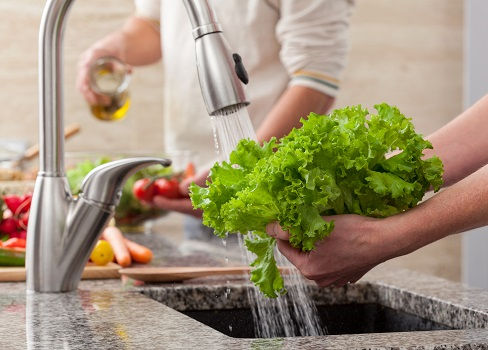
Cooking and preparing meals at home can help you connect with family and friends, eat healthier and more nutritious food, and save some money. But even a seasoned home chef can make mistakes that could lead to food-borne illnesses such as salmonella or food poisoning.
Thomas Norris, executive chef with Atlantic Health System, has tips and guidelines to safely prepare your favorite foods in your home kitchen.
Cleanliness
Norris says the single most important thing you can do to prevent food-borne illnesses when preparing food is to thoroughly and frequently wash your hands.
“Hand washing is an essential step in the cooking process,” Norris says. “You should be washing your hands before you handle food and frequently throughout the cooking process, as well as before eating.”
It’s also crucial to keep your kitchen and food preparation surfaces clean and sanitized. Your cutting boards, knives and utensils should be kept clean and in good repair. Norris explains that a simple solution containing one teaspoon of liquid bleach and one quart of water is safe to use on most surfaces and is more than 99% effective in killing most strains of bacteria.
Cluttered kitchen surfaces can lead to cross-contamination, and Norris says that it’s important to clear off surfaces and immediately wipe up any spills. Use separate cutting boards and utensils for raw and cooked foods, and clean and sanitize them before you use them again. Washing all fruits and vegetables with a veggie wash, including fruits that will be peeled or cut (such as melons and bananas), will help to reduce contaminants.
Food Storage
When it comes to food storage, Norris recommends you mimic how foods are presented in grocery stores. For example, if an item was refrigerated at the store, you should do the same when you get it home. After grocery shopping, refrigerate your food within two hours. Insulated bags can help to extend that time if you have a long trip home from the grocery store.
Norris explains that 40 degrees is the magic number for most foods that need to be kept cold. He suggests you keep your refrigerator temperature set at that number or lower. Food that’s between 41 and 135 degrees allows bacteria to grow so it can quickly become unsafe to eat.
Try to avoid overcrowding your refrigerator and wipe it down once a week to keep bacteria at bay. Norris explains that properly organizing your fridge can help prevent cross-contamination. Put ready-to-eat foods at the top, seafood next, then raw meat, ground meat and finally poultry at the bottom.
If you don’t plan to cook or use an item within one or two days, Norris suggests freezing it. How long you can safely store food depends on whether it is cooked or raw and whether you plan to refrigerate or freeze the item. The US Department of Agriculture has guidelines for the safe storage of a wide range of food items, and you can search for a specific item on the Foodkeeper app.
Some signs your food might be spoiled, even if it’s within the item’s expiration date, include a foul odor, slimy texture or discoloration. Norris also urges you to keep an eye on the expiration dates printed on food items.
“Some people think expiration dates are just a suggestion, especially when it comes to canned goods,” says Norris. “It’s simply not true. When it doubt throw it out. It’s not worth the risk.”
Thawing and Cooking Food
There are three safe methods to defrost food. You can either put items in the fridge overnight, run them under water that is colder than 40 degrees or use the defrost function on your microwave.
“You’ll notice that leaving frozen food on the counter to thaw isn’t on that list,” says Norris. “It’s not safe to leave perishable food at room temperature for an extended time, even if it’s frozen.”
Whether you like to grill, bake or use an air fryer, it’s important to ensure your food is thoroughly cooked. While using a timer can get you into the right range, Norris recommends using a properly calibrated instant-read thermometer to determine whether your food has reached the correct temperature. Food is safe to eat when it reaches these temperatures for 15 seconds:
- Chicken – 165 degrees
- Ground meat and sausage – 160 degrees
- Fish, chops, roasted meat and eggs – 145 degrees
You can store leftovers in the fridge for about five days.
“It doesn’t matter if you’re an experienced cook or if you like to dabble in the kitchen after watching a cooking show,” he says. “By following a few simple guidelines, everyone has the skills required to safely prepare healthy meals at home and have a good time in the process.”